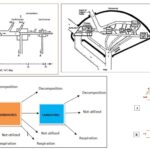IB Biology 13 Views 1 Answers
Sourav PanLv 9November 9, 2024
How do unique molecules on the surface of cells help in distinguishing between self and non-self in organisms?
How do unique molecules on the surface of cells help in distinguishing between self and non-self in organisms?
Please login to save the post
Please login to submit an answer.
Sourav PanLv 9May 15, 2025
Unique molecules on the surface of cells play a crucial role in distinguishing between self and non-self in organisms, particularly within the immune system. This recognition is fundamental for maintaining homeostasis and protecting the body from pathogens. Here’s how these molecules contribute to this process:
Mechanisms of Self-Non-Self Discrimination
- Major Histocompatibility Complex (MHC) Molecules:
- MHC molecules are critical for the immune system’s ability to recognize self versus non-self. They present peptide fragments derived from proteins within the cell to T cells. MHC class I molecules present endogenous antigens (from within the cell) to CD8+ cytotoxic T cells, while MHC class II molecules present exogenous antigens (from outside the cell) to CD4+ helper T cells. The recognition of these peptide-MHC complexes by T cell receptors (TCRs) allows T cells to distinguish between healthy self-cells and infected or cancerous cells.
- T Cell Receptor (TCR) Specificity:
- TCRs are designed to recognize specific antigens presented by MHC molecules. During thymic selection, T cells that recognize self-peptides with low affinity are allowed to survive, while those that react strongly against self-antigens are eliminated. This process ensures that T cells are equipped to recognize foreign antigens while minimizing autoimmunity. The ability of TCRs to differentiate between self and non-self is crucial for effective immune responses.
- Pattern Recognition Receptors (PRRs):
- Innate immune cells use PRRs to detect pathogen-associated molecular patterns (PAMPs), which are unique to microbes and absent from host cells. For example, Toll-like receptors (TLRs) on macrophages can recognize bacterial lipopolysaccharides or viral RNA, triggering an immune response against non-self entities. This immediate recognition helps the body respond quickly to infections.
- “Missing Self” Recognition:
- Natural killer (NK) cells utilize a mechanism known as “missing self” recognition, where they identify healthy cells by their expression of MHC class I molecules. Infected or transformed cells often downregulate MHC class I expression, making them susceptible to NK cell-mediated lysis. This mechanism allows NK cells to distinguish between normal self-cells and those that have become abnormal due to infection or malignancy.
- Self-Ligands and Co-stimulation:
- The interaction between self-ligands and receptors on immune cells can modulate their activation state. For instance, continuous engagement of TCRs with self-peptide/MHC complexes provides a tonic signal necessary for maintaining T cell readiness without triggering full activation against self. This balance is essential for preventing autoimmune responses while ensuring that T cells remain responsive to foreign antigens.
Significance
Understanding how unique surface molecules facilitate the distinction between self and non-self is vital for several reasons:
- Immune System Functionality: Proper functioning of the immune system depends on its ability to accurately identify and eliminate pathogens while sparing healthy tissues.
- Autoimmunity Prevention: Mechanisms that prevent the recognition of self as non-self help avoid autoimmune diseases, where the immune system mistakenly attacks the body’s own tissues.
- Therapeutic Applications: Insights into these recognition processes can inform therapeutic strategies, such as designing vaccines or immunotherapies that enhance immune responses against tumors or infectious agents.
0
0 likes
- Share on Facebook
- Share on Twitter
- Share on LinkedIn
0 found this helpful out of 0 votes
Helpful: 0%
Helpful: 0%
Was this page helpful?




